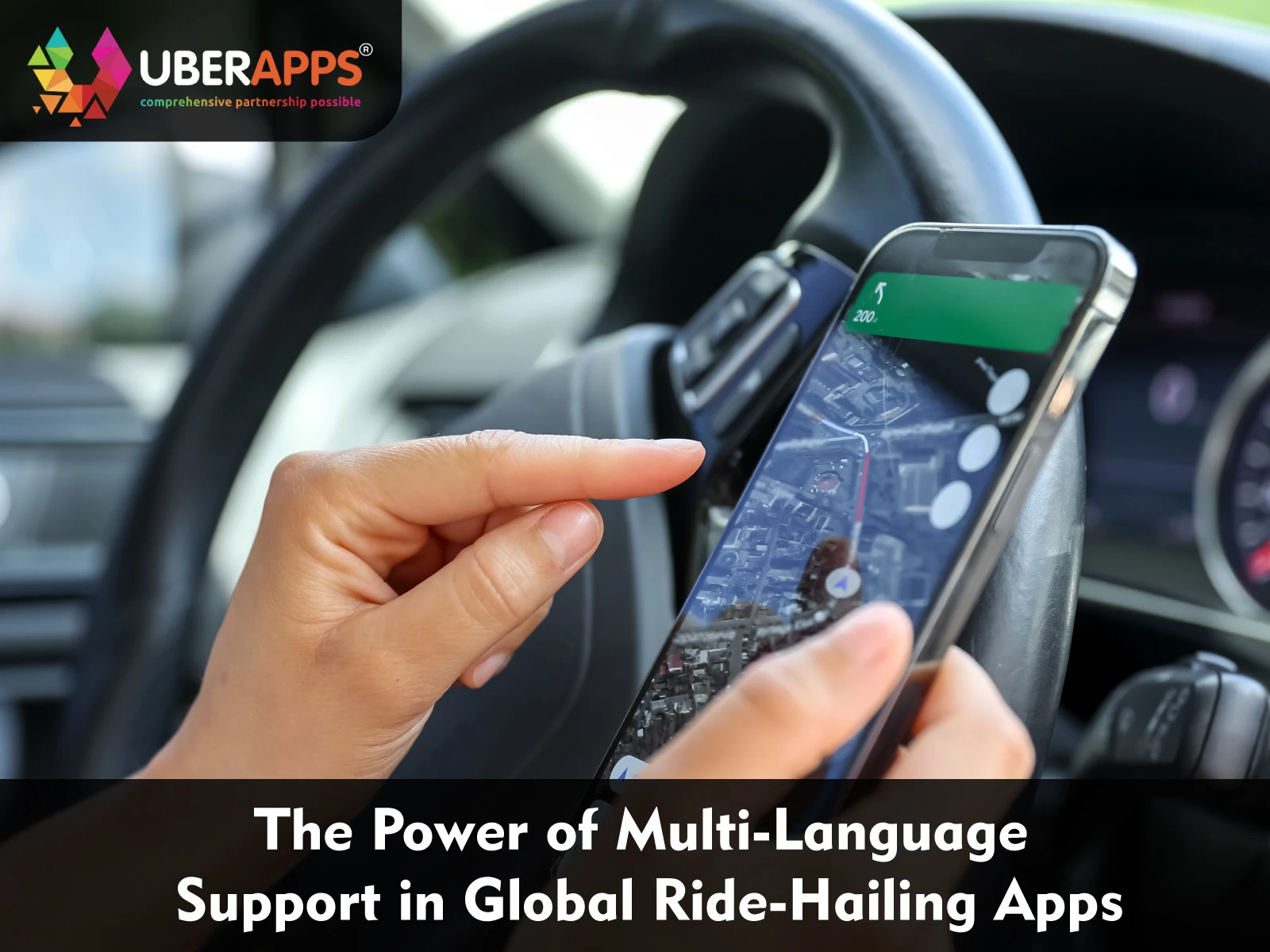
The Power of Multi-Language Support in Global Ride-Hailing Apps
In the dynamic world of ride-hailing, localization is no longer optional—it’s essential. Whether you’re building an Uber clone or launching your own taxi booking app, offering multi-language support instantly broadens your audience and creates a more personalized experience for users around the world. A rider in Dubai, a driver in Kenya, or a tourist in Paris should all be able to interact with your app seamlessly. Multi-language features empower your taxi app to break communication barriers, increase retention, and deliver trust-driven experiences.
Let’s explore how integrating multiple languages into your ride-hailing app development strategy strengthens your brand’s global identity and drives sustainable growth.
In today’s global digital economy, ride-hailing apps are redefining mobility and accessibility. As these platforms expand across continents, multi-language support has become a powerful competitive advantage. Language customization does not only improve the user experience but also enhances rider-driver communication, app accessibility, and overall market adoption. Ride-hailing giants and emerging startups alike now realize that localization is key to scaling globally. With modern taxi booking apps like UBERApps, multi-language integration is seamless—allowing users to interact in their native language and driving stronger engagement. In this blog, you’ll explore how multi-language support impacts customer acquisition, boosts app usability, and propels your business to new regions. You’ll also learn about advanced taxi app development strategies, in-app payment integration, and features that build trust in multilingual markets.
Why Multi-Language Support Matters in Taxi Booking Apps
1 Expanding Your Global Reach
Having multi-language functionality allows taxi booking apps to serve users across different regions with comfort and confidence. Users prefer services that communicate in their native language making this feature a driver of customer loyalty and trust.
Key benefits:
- Easier adoption in non-English-speaking markets
- Increased rider and driver registrations
- Enhanced satisfaction and customer retention
- Competitive advantage in global expansion
A multi-language taxi app like UBERApps helps startups easily customize content and deliver region-specific experiences without rebuilding the entire platform.
2 Enhancing User Experience (UX)
Localized UI/UX Design
Offering localization across menus, buttons, notifications, and receipts creates convenience for riders and drivers alike. It ensures riders can navigate the app seamlessly and drivers clearly understand trip details, boosting efficiency.
Culturally Adaptive Communication
A well-designed multilingual taxi app adjusts not just words but also tone and cultural expressions. This helps prevent misinterpretations and fosters a stronger emotional connection with users.
3 Empowering Drivers in Diverse Markets
Drivers often come from different linguistic backgrounds, especially in global cities. Multi-language support helps improve communication between riders, dispatchers, and drivers.
Advantages:
- Reduced cancellation rates
- Accurate ride communication
- Improved driver onboarding
- Enhanced performance monitoring
By removing language hurdles, drivers can focus on safe driving and excellent service delivery.
Building Multi-Language Ride-Hailing Apps: Key Considerations
1 Language Localization Strategy
To effectively localize your app, focus on three aspects:
- Regional dialects: Adjust text for local variations (e.g., Brazilian Portuguese vs. European Portuguese).
- Cultural preferences: Use icons, colors, and date formats familiar to specific audiences.
- Voice integration: Implement multi-language voice commands for a smoother in-app experience.
2 Integration with Translation Frameworks
Use translation management systems (TMS) like Google Cloud Translation API or i18next for dynamic language translation. This ensures accuracy without compromising performance.
3 Testing Multilingual Interfaces
Your QA process should cover:
- Character encoding for non-Latin text
- Alignment issues in right-to-left languages like Arabic
- Correct display of currency, units, and addresses
- Voice and text consistency during ride updates
How Multi-Language Features Improve Ride-Hailing App Success
Boosting Rider Conversion Rates
Localized apps generate higher downloads and conversions because they speak directly to users in their preferred language. Studies show app localization can boost installs by over 26%.
Reducing Operational Friction
When dispatch messages, receipts, and route details are presented in the driver’s or rider’s chosen language, misunderstandings reduce drastically—improving ratings and fewer dispute tickets.
Strengthening Brand Trust
Offering multiple languages demonstrates inclusivity and care. It resonates with riders, showing that the company values diverse backgrounds and accessibility.
Multi-Language Integration in Uber Clone Apps
Why It’s the Core of Modern Taxi App Development
Today’s Uber clone apps must cater to diverse linguistic regions without separate codebases. With a white-label taxi app solution like UBERApps, you can manage multiple languages under a single admin dashboard.
Features Supported:
- Admin-controlled multilingual settings
- Add, edit, or remove languages dynamically
- Customize banner text, notifications, and policy documents
- Region-specific promotions and content localization
This scalable architecture allows your ride-hailing platform to adapt swiftly as you launch in new markets.
Technical Implementation: Backend and Front-End
Backend
- Use JSON or XML resource files for storing translations.
- Maintain separate language folders in your codebase for each market.
- Integrate a translation API for automated text updates.
Front-End
UI should automatically detect the phone’s language preference. Allow users to switch languages through an in-app menu. Keep content adaptive for right-to-left languages like Arabic or Urdu.
Linking Multi-Language Support with In-App Payments
Why Localization Matters for Payments
When users book taxis through an app, language consistency enhances payment confidence. In multilingual markets, payment confirmation screens and fare breakdowns must be easily understood.
Implementing Localized Payment Experiences
- Display currency symbols and tax details regionally.
- Translate error and success messages for every payment gateway.
- Support local wallets (e.g., M-Pesa, Paytm, or Orange Money).
By combining in-app payments and multilingual support, you build reliability and simplify transactions across countries.
Best Practices for Scaling Multi-Language Taxi Apps
1 Start with High-Volume Regions
Focus on languages with the largest potential user bases—Spanish, Arabic, French, Portuguese, and Hindi—before gradually expanding.
2 Collect Feedback
Encourage riders and drivers to suggest corrections or improvements for translations. Incorporating real feedback improves authenticity.
3 Automate Language Updates
Use automated sync systems so text changes made in the admin panel reflect immediately in all active app versions.
4 Optimize SEO for Multi-Regional Search
Maintain language-specific keyword strategies to strengthen visibility on local app stores and search engines.
Case Study: UBERApps’ Multi-Language System
UBERApps has successfully implemented over ten languages, including Arabic, Spanish, French, and Hindi. The solution allows admins to localize each city’s taxi operation by:
- Adding translation packs manually or via automation
- Configuring city-specific fare formats
- Handling currencies and unit conversions
- Running analytics reports filtered by language zone
This capability has empowered startups on every continent to reach users effectively while maintaining robust app performance.
Future of Multi-Language Localization in Ride-Hailing Apps
AI and Machine Learning Advancements
AI-driven localization tools can automatically detect the region, suggest translations, and modify tone. Machine learning allows adaptation based on user preferences.
Voice and Conversational Interfaces
The next wave includes multilingual virtual assistants helping riders book trips through speech. Taxi apps are integrating voice-to-text booking features to further remove typing barriers.
Regulatory Compliance and Cultural Sensitivity
Future localization will ensure compliance with country-specific regulations and content sensibilities, strengthening trust and reducing legal risks globally.
Benefits Summary
- Wider market reach and more user adoption
- Better user experience through personalization
- Enhanced driver communication and reduced errors
- Stronger trust via inclusive customer service
- Easier regional marketing and SEO targeting
Localization is your bridge from one region to many. It transforms a static app into a truly global mobility ecosystem.
Conclusion
Multi-language support is not just an accessory; it is a core foundation of global ride-hailing success. A rider’s comfort with the app language directly influences engagement and satisfaction. When a driver and rider both understand the trip flow clearly, service quality improves, leading to positive feedback and loyalty. As your ride-hailing business scales beyond borders, the ability to customize languages quickly gives you a sustainable edge. By integrating localization early in your taxi app development, you ensure every user feels at home no matter their country or language.
Solutions like UBERApps make this process frictionless, empowering you to manage language packs, currencies, and UX adaptations within one control panel. With multi-language, multi-currency, and compliance-ready features, your Uber clone app can truly become a "global" platform—driving inclusion, efficiency, and growth in the on-demand taxi market.
FAQS
1. Why is multi-language support vital in taxi booking apps?
Multi-language support ensures users across different regions can interact easily with the platform, improving trust, increasing ride requests, and enabling more driver onboarding.
2. How does localization affect ride-hailing app engagement?
Localization tailors content to a user’s culture and language, helping them navigate comfortably and resulting in higher app retention and user satisfaction.
3. Can a multi-language taxi app help expand to new countries?
Yes, language accessibility simplifies expansion into new markets by aligning with local linguistic and cultural preferences, making global scaling easier.
4. How do developers add new languages to a taxi app?
Developers use translation frameworks and admin panels that enable dynamic content translation without requiring additional heavy development cycles.
5. Which languages should be prioritized in global taxi apps?
Popular languages like English, Spanish, Arabic, French, Portuguese, and Hindi should be prioritized to maximize global reach and inclusivity.
Author's Bio

Vinay Jain is the Founder of UBERApps and brings over 10 years of entrepreneurial experience. His focus revolves around software & business development and customer satisfaction.

